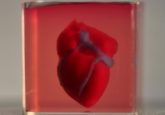New finding could increase heart transplant rate

Researchers demonstrate that many donor organs dismissed as unusable for heart transplant due to stress-induced heart failure could be accepted, increasing potential donors by up to 30%.
Heart transplant is still considered the best strategy for end-stage heart failure patients despite recent advances in alternative treatments. Unfortunately, the feasibility of a heart transplant is limited by the shortage of suitable organ donors.
However, new research from the University of Gothenberg (Sweden) may provide the answers to increase donors for heart transplants by 20–30% by demonstrating that hearts previously considered unsuitable can be used in heart transplants.
The study, published recently in the Journal of Thoracic and Cardiovascular Surgery, reviewed the records of 641 potential donors for heart transplants in western Sweden between 2006 and 2016 to assess the incidence of left ventricular dysfunction (LVD) and its influence of recipient outcomes.
- Carbon nanotube fibers restore damaged hearts
- Regenerating the heart
- Building miniature hearts to improve clinical trials
LVD is an abnormality of the heart, frequently observed in potential heart transplant donors, that often leads to the heart being dismissed as unusable. However, this could be a temporary consequence of the surge of catecholamines released after brain death.
The researchers discovered that 24% of the 641 potential donor hearts and 14% of the 338 hearts used in heart transplants had LVD. A higher incidence of LVD was witnessed in donors of a younger age, who died of a consequence of cardiac arrest or who experienced a shortened time between admission and brain death.
While LVD was a major determinant of whether a heart was used for heart transplant, the outcomes for recipients were independent of the presence of LVD in the heart used. Left ventricle function normalized in recipients within a few hours or days.
“We estimate that the supply of donor hearts could be increased by 20–30% if these hearts are used.”
“The impairment in cardiac function seems to be temporary and is not caused by coronary artery disease or other heart disease,” explains Jonatan Oras, lead author for the study. “This fact fits well with stress-induced heart failure. When we repeatedly examine these hearts, we see that their function recovers quickly.”
These findings indicate that hearts with LVD can be safely transplanted and thus should not be disqualified from heart transplantation. The use of these hearts may significantly increase heart transplant rates.
“We estimate that the supply of donor hearts could be increased by 20–30% if these hearts are used,” concludes Oras.
